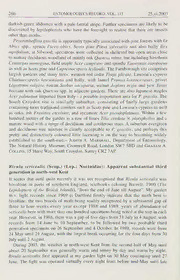
Rivula sericealis (Scop.) (Lep.: Noctuidae): Apparent substantial third generation in north-west Kent PDF
Preview Rivula sericealis (Scop.) (Lep.: Noctuidae): Apparent substantial third generation in north-west Kent
, 286 ENTOMOLOGIST'S RECORD, VOL. 115 25.xi.2003 darkish-green abdomen with a pale lateral stripe. Further specimens are likely to be discovered by lepidopterists who have the foresight to realise that there are insects other than moths. Peyerimhoffina gracilis is apparently typically associated with pine forests with fir Abies spp., spruce Picea abies, Scots pine Pinas sylvestris and also holly Ilex aquifolium at Silwood, specimens were collected in sheltered but open areas close ; to mature deciduous woodland of mainly oak Quercus robur but including hawthorn , Crataegus monogyna, field maple Acer campestre and spindle Euonymus europaeus as well as Scots pine and Cupressocyparis leylandii. The Farnborough site comprises largish gardens and many trees: western red cedar Thuja plicata, Lawson’s cypress Chamaecyperis lawsonianci and holly, with laurel Prunus laurocerasus, privet Ligustrum vulgare rowan Sorbus aucuparia, walnut Juglans regia and yew Taxus baccata with oak Quercus spp. in adjacent gardens. There are also Japanese maples Acer palmatum imported from Italy - a possible importation area for P. gracilis. The South Croydon site is similarly suburban, consisting of fairly large gardens containing more traditional conifers such as Scots pine and Lawson’s cypress as well as oaks, ash Fraxinus excelsior, and sycamore Acer pseudoplatanus. Within a few hundred metres of the garden is a row of limes Tilia corclata x platyphyllos and a mature wood with a range of deciduous and coniferous trees. A suburban evergreen and deciduous tree mixture is clearly acceptable to P. gracilis, and perhaps this pretty and distinctively coloured little lacewing is on the way to becoming widely established in the south-east.- Judith A. Marshall, Department of Entomology, The Natural History Museum, Cromwell Road, London SW7 5BD and Graham A. Collins, 15 Hurst Way, South Croydon, Surrey CR2 7AR Rivula sericealis (Scop.) (Lep.: Noctuidae): Apparent substantial third generation in north-west Kent It seems that until quite recently it was not recognised that Rivula sericealis was bivoltine in parts of southern England, textbooks echoing Barrett, 1900 (The My Lepidoptera of the British Islands), “from the end of June till August”. garden m.v. light records since 1969 at Dartford firmly indicate that the moth here is bivoltine, the two broods of moth being readily recognized by a substantial gap of three to four weeks every year except 1988 and 1989, years of abundance of sericealis here with more than one hundred specimens being noted at the trap in each year. However, in 1988, there was a gap of five days from 31 July to 4 August, with records from 14 June to 10 September, to be followed by two probable third generation specimens on 26 September and 4 October. In 1989, records were from 24 May until 24 August, with the largest break occurring for the four days from 30 July until 2 August. During 2003, the weather in north-west Kent from the second half of May until about 20 September was generally warm and sunny by day and warm by night. Rivula sericealis first appeared at my garden light on 30 May continuing until 27 June. The light was operated virtually every night from before mid-May until late NOTES 287 September. In June, R. sericealis was recorded every night except the 22nd, 24th and 26th. After 27 June, the next example was recorded on 18 July and, with a slight faltering at the start and end of the sequence, appeared nightly until 24 August. Then, after a gap of 25 days, on 17 September a further specimen was noted, followed by others on the next four nights and 26 September producing a total of 14 moths, a figure that may not accurately reflect the true strength of this probable third brood. After 11 September, only one m.v. light was operated, instead of two, while 19 September initiated a long period of cold, clear nights on which species numbers fell from 20 by 25% to 40% with a corresponding fall in numbers of individuals. Also, after 11 September, the light was operated only from 17 to 21 September inclusive, 26 and 30 September, October and then 8 October to the end of that month. The 1 year 2003, like 1988 and 1989, was a year of comparative abundance for R. sericealis while over the 34 years since 1969 this species has, in general, been , erratic in appearance; 2003 is the fifth year in succession with recordings being well above average. Probable third generation moths have occurred as singletons well after the second brood appeared to have ended, These are listed below together with their last previous appearance in that year. Date in year Year last preceding record in that year 10 October 1971 29 August 13 September 1984 21 August 12 September 1987 23 August 26 September 1988 10 September* 4 October 1988 26 September* 10 October 1997 27 August October 2001 27 August 1 1 October 2002 29 August 1 * = same year A number of moths appear to produce occasional specimens to be recorded long after the second broad seems over. Examples includes Ectropis bistortata (Goeze), , Selenia dentaria (Fabr.) and Idaea seriata Schrank. In 2003., R. sericealis may have improved on this at Dartford.- B. K. West, 36 Briar Road. Dartford, Kent DA5 2HN. Two new butterfly records from the Greek island of Corfu in May 2003 During our stay on Corfu from 25 to 31 May 2003, we recorded 51 species of butterfly. Based on the checklist in Parker (1996, Bull. Amat. Ent. Soc. 55: 175-183, 254-255), in which he listed the 78 species recorded from Corfu, it would appear that two of our species are new for the island. The first of these was Satyrium acaciae (Fabr.), of which we found two fresh males - one at Episkepsi at 275 metres above
